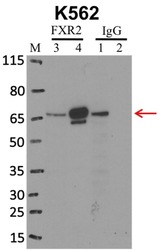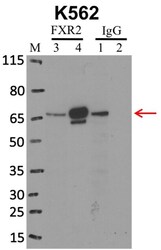Antibody data
- Antibody Data
- Antigen structure
- References [4]
- Comments [0]
- Validations
- Immunocytochemistry [2]
- Immunoprecipitation [1]
- Other assay [1]
Submit
Validation data
Reference
Comment
Report error
- Product number
- MA1-16767 - Provider product page

- Provider
- Invitrogen Antibodies
- Product name
- FXR2 Monoclonal Antibody (1G2)
- Antibody type
- Monoclonal
- Antigen
- Recombinant protein fragment
- Description
- Suggested positive control: Hela whole cell extract, HeLa whole cell lysate.
- Reactivity
- Human, Mouse
- Host
- Mouse
- Isotype
- IgG
- Antibody clone number
- 1G2
- Vial size
- 100 μL
- Concentration
- 1.0 mg/mL
- Storage
- Store at 4°C short term. For long term storage, store at -20°C, avoiding freeze/thaw cycles.
Submitted references Aberrant NOVA1 function disrupts alternative splicing in early stages of amyotrophic lateral sclerosis.
Generation of monoclonal antibodies against phosphotyrosine and their use for affinity purification of phosphotyrosine-containing proteins.
Generation of monoclonal antibodies against phosphotyrosine and their use for affinity purification of phosphotyrosine-containing proteins.
Protein-tyrosine kinase activity and pp60v-src expression in whole cells measured by flow cytometry.
Krach F, Wheeler EC, Regensburger M, Boerstler T, Wend H, Vu AQ, Wang R, Reischl S, Boldt K, Batra R, Aigner S, Ravits J, Winkler J, Yeo GW, Winner B
Acta neuropathologica 2022 Sep;144(3):413-435
Acta neuropathologica 2022 Sep;144(3):413-435
Generation of monoclonal antibodies against phosphotyrosine and their use for affinity purification of phosphotyrosine-containing proteins.
Frackelton AR Jr, Posner M, Kannan B, Mermelstein F
Methods in enzymology 1991;201:79-92
Methods in enzymology 1991;201:79-92
Generation of monoclonal antibodies against phosphotyrosine and their use for affinity purification of phosphotyrosine-containing proteins.
Frackelton AR Jr, Posner M, Kannan B, Mermelstein F
Methods in enzymology 1991;201:79-92
Methods in enzymology 1991;201:79-92
Protein-tyrosine kinase activity and pp60v-src expression in whole cells measured by flow cytometry.
Preis PN, Waldman FM, Frackelton AR Jr, Saya H, Levin VA
Cancer research 1988 Aug 15;48(16):4633-8
Cancer research 1988 Aug 15;48(16):4633-8
No comments: Submit comment
Supportive validation
- Submitted by
- Invitrogen Antibodies (provider)
- Main image

- Experimental details
- Immunofluorescent analysis of FXR2 in A431 cells. The cells were fixed with 100% methanol for 15 minutes at -20C, permeabilized with 0.1% Triton X-100 for 15 minutes, and blocked with 3% BSA for 30 minutes at room temperature. Cells were stained with a FXR2 mouse monoclonal antibody (Product # MA1-16767) at a concentration of 5 µg/mL in blocking buffer overnight at 4C, and then incubated with a Goat anti-Mouse IgG (H+L) Highly Cross-Adsorbed Secondary Antibody, Alexa Fluor® Plus 488 conjugate (Product # A32723) at a dilution of 1:500 for at least 30 minutes at a room temperature in the dark (green). Nuclei (blue) were stained with Hoechst 33342 (Product # 62249). Images were taken on a Thermo Scientific ToxInsight Instrument at 20X magnification
- Submitted by
- Invitrogen Antibodies (provider)
- Main image

- Experimental details
- Immunofluorescent analysis of FXR2 in A431 cells. The cells were fixed with 100% methanol for 15 minutes at -20C, permeabilized with 0.1% Triton X-100 for 15 minutes, and blocked with 3% BSA for 30 minutes at room temperature. Cells were stained with a FXR2 mouse monoclonal antibody (Product # MA1-16767) at a concentration of 5 µg/mL in blocking buffer overnight at 4C, and then incubated with a Goat anti-Mouse IgG (H+L) Highly Cross-Adsorbed Secondary Antibody, Alexa Fluor® Plus 488 conjugate (Product # A32723) at a dilution of 1:500 for at least 30 minutes at a room temperature in the dark (green). Nuclei (blue) were stained with Hoechst 33342 (Product # 62249). Images were taken on a Thermo Scientific ToxInsight Instrument at 20X magnification
Supportive validation
- Submitted by
- Invitrogen Antibodies (provider)
- Main image

- Experimental details
- Immunoprecipitation of FXR2 was performed on K562 cells. Antigen-antibody complexes were formed by incubating approximately 500 µg whole cell lysate with 5 µg of FXR2 monoclonal antibody (Product # MA1-16767) rotating 60 min at RT. The immune complexes were captured on 625 µg of anti-mouse coated Dynabeads (Product # 11202D), washed extensively, and eluted with NuPAGE™ LDS Sample Buffer (Product # NP0007). Samples were resolved onto NuPAGE™ 4-12% Bis-Tris gel (Product # NP0335BOX). Lanes 1 and 3 are input and lanes 2 and 4 are IP. Proteins were transferred to PVDF membrane (Product # IB23001). Membrane was blocked in 5% milk. Target was detected using a FXR2 monoclonal antibody (Product # MA1-16767) at a dilution of 1:2000, followed by a 1:4000 dilution of secondary antibody. Chemiluminescent detection was performed using ECL Western Blotting Substrate (Product # 32106). Data courtesy of the Yeo lab as part of the ENCODE project (www.encodeproject.org).
Supportive validation
- Submitted by
- Invitrogen Antibodies (provider)
- Main image

- Experimental details
- RNA immunoprecipitation (RIP) western of FXR2 was performed on K562 cells. Antigen-antibody complexes were formed by incubating approximately 500 µg whole cell lysate with 5 µg of FXR2 monoclonal antibody (Product # MA1-16767) rotating 60 min at RT. The immune complexes were captured on 625 µg of anti-mouse coated Dynabeads (Product # 11202D), washed extensively, and eluted with NuPAGE™ LDS Sample Buffer (Product # NP0007). Samples were resolved onto NuPAGE™ 4-12% Bis-Tris gel (Product # NP0335BOX). Lanes 1 and 3 are input and lanes 2 and 4 are IP. Proteins were transferred to PVDF membrane (Product # IB23001). Membrane was blocked in 5% milk. Target was detected using a FXR2 monoclonal antibody (Product # MA1-16767) at a dilution of 1:2000, followed by a 1:4000 dilution of secondary antibody. Chemiluminescent detection was performed using ECL Western Blotting Substrate (Product # 32106). Data courtesy of the Yeo lab as part of the ENCODE project (www.encodeproject.org).
 Explore
Explore Validate
Validate Learn
Learn Western blot
Western blot Immunocytochemistry
Immunocytochemistry Immunohistochemistry
Immunohistochemistry